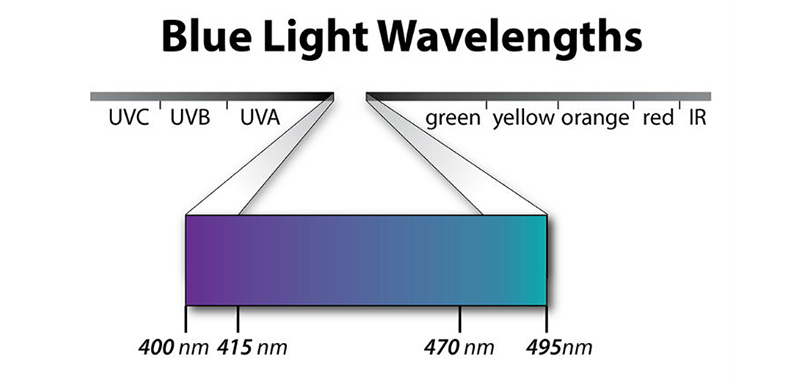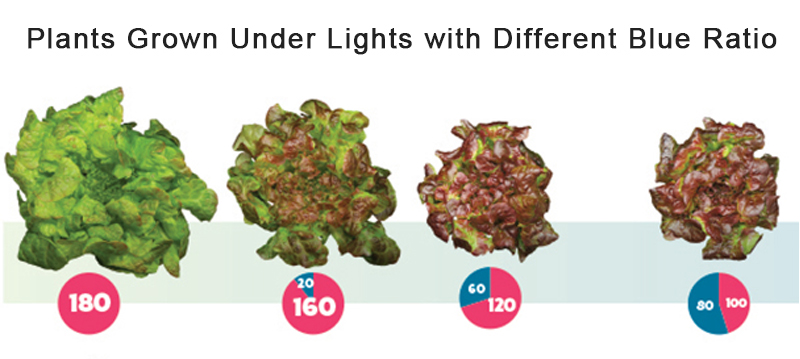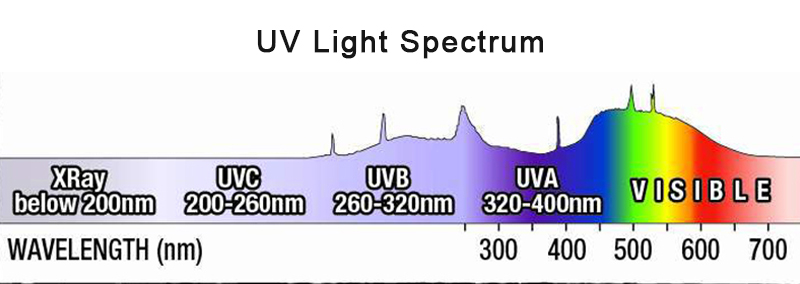What is a full spectrum LED grow light?
As we know, light is basically electromagnetic waves. No matter it is high frequency such as gamma rays or low frequency of radio waves, or the visible wavelength within 400-700nm, all can be theoretically called ”light”. By now, there is no artificial lighting device, not even the sun that can emit light covering the full spectrum of light. So in this field of physics, there is no such thing that can be called full spectrum LED grow lights.


But in horticulture lighting, the full spectrum is usually referred to the spectrum covering the major part of plant photosynthesis-effective light wavelength, namely 400nm to 700nm, same as the visible light spectrum of human eyes. We call this part of light spectrum as PAR(Photosynthesis-Active Radiation), because the two main photosynthetic pigments of Chlorophyll A and Chlorophyll B which are responsible for photosynthesis absorb the photons within this range of light spectrum.
The full spectrum LED grow lights, hereby, are LED lighting bulbs that can output light covering the full range of wavelengths from 400nm to 700nm.
*Photosynthetic pigments ( including accessory pigment, chloroplast pigment, antenna pigment) are natural plant compounds existing in chloroplasts of all plants or photosynthetic bacteria and absorb the light of certain wavelength for photosynthesis.


Full Spectrum is one variety of light spectrum, not one specific light spectrum
As we mentioned above, for a plant LED grow light, any light that is capable of emitting light of wavelength covering the 400nm-700nm can be called a full spectrum light. But the ratio of each wavelength within the light spectrum of different grow lights could be significantly different. For example, grow light of white 3000K and grow light of white 5000K can be both called full spectrum LED grow light, but the color ratio of each light is completely different.

How does the light of different wavelengths affect plant growing?
The relations of Photosynthetic Pigments and Light
First, we need to understand a bit of the relation between light and photosynthetic pigment.
Basically, all land plants contain several types of photosynthetic pigments, as below.
Carotene: an orange pigment
Xanthophyll: a yellow pigment
Phaeophytin a: a gray-brown pigment
Phaeophytin b: a yellow-brown pigment
Phycocyanin: an orange-red light
Chlorophyll a: a blue-green pigment
Chlorophyll b: a yellow-green pigment

Each of these pigments absorbs light more efficiently of different wavelengths.
Among these pigments Chlorophyll a is the most common, existing in every plant that performs photosynthesis. Chlorophyll a is also the most important one because it is directly involved in the conversion of light energy (photons) to chemical energy.
For this reason chlorophyll a is called the primary photosynthetic pigment.
While other pigments found in the chloroplasts of higher plants are called "accessory pigments", such as chlorophyll b, carotenoids and xanthophylls, and the phycobillins. The accessory pigments absorb light of different wavelengths and transfer part of that energy to chlorophyll a. Thus, the accessory pigments help to increase the efficiency of light utilization in photosynthesis.
We also need to understand that the volume and ratio of every photosynthetic pigment in different varieties of plants, even in different strains, are variable. That’s why different plants respond to the same light spectrum so differently.
We can see from the picture above of “Photosynthetic Pigments’ Relative Absorption of Light Photons of Different Wavelength” that Chlorophyll a absorbs well at a wavelength of about 400–450 nm(Blue) and at 650–700 nm(Red); chlorophyll b at 450–500 nm and at 600–650 nm, Xanthophyll at 400–530 nm. None of the pigments absorbs well in the green-yellow region, that’s why we see the abundant green in nature.
BUT, Photosynthesis Is Far From Being The Whole Picture of How Plants Respond to Light
The above explanation of the relations of Photosynthetic Pigments and Light shows how light delicately affects the photosynthesis of plants.
But, except photosynthesis, plants have a number of sophisticated uses for light that go far beyond only performing photosynthesis, such as:
Photoperiodism: Plants can tell the time of day and time of year by sensing and using various wavelengths and the length of day and night. Therefore plants will respond accordingly to perform different types or stages of growth, development, like flowering control by artificial day time variation.
Photomorphogenesis: Plants naturally tend to optimize their use of light and space and can differentiate the development of plant cells, tissues and organs in response to different light environments.
Phototropism: Light also elicits a directional response in plants that stimulate the movement of a plant toward or away from light.
So in a much bigger picture of how light affects plants growing, and according to the accumulation of knowledge and data from the long history of research on plant and light, we can have a relatively clear picture of how generally different light affects plant growing as below.
Red Light

Red light is usually defined as light of wavelengths between 620 and 700 nm. Although the luminous efficiency of red light is comparatively low, which means red light appears relatively dim to people, it has a high relative quantum efficiency and is highly absorbed by the red-absorbing form of phytochrome. Therefore, red is often the primary light spectrum used for photosynthetic and photoperiodic lighting.
Red light on photosynthesis

The McCree curve quantifying the efficiency of different colors of light at stimulating photosynthesis on an instantaneous basis shows that the relative quantum efficiency of red light is highly effective at promoting plant growth. Therefore, it is among the best colors of light to stimulate plant growth.
Red light on Photomorphogenesis
Many plants grown indoors under only red LEDs usually have a stretched, elongated appearance; the leaves are thin and large and plants become abnormally tall. In most cases, plants grown under only red light do not have the desired growth characteristics of being compact and strong.
Red light on flowering
The pigment phytochrome which mediates the flowering process of plants with a photoperiodic flowering response is very sensitive to red light, even at a very low intensity. During the night, 1 µmol/m2/s of red light can inhibit flowering of short-day plants and promote some long-day plants to start flowering because of plant’s high sensitivity to red light.
Blue Light(400nm-495nm)

Blue light is usually referred to as the part of light of wavelengths within the 400 and 500 nm which is directly related to chlorophyll production. This waveband is within the visible light spectrum, with relatively high energy, and elicit pronounced effects on plant vegetative growth and flowering. Generally speaking, plants growing with enough blue light will have strong, healthy stems and leaves.
Blue light on photosynthesis
Although from an energy efficiency view, it seems that blue light is less efficient than green or red photons because their high energy isn’t fully utilized. But a minimal intensity of blue light is a must in most indoor lighting applications for normal plant growth. Moreover, blue light is responsible for the regulation of stomata opening, the tiny plant organs on leaves that control both water loss and the uptake of CO2.
Blue light on Photomorphogenesis
Generally, blue light can suppress the undue extension growth of plants; plants grown with blue-heavy light are usually shorter, having smaller, thicker and darker green leaves compared to plants growing under light lack of blue spectrum.
Therefore, indoor lighting (e.g. vertical farming) and greenhouse supplemental lighting usually have higher blue in the grow light spectrum than other full spectrum LED lights.

Blue light on flowering
Flowering plants do not respond to blue light as the same sensitive as red light.
A low intensity of blue light, such as 1-2 µmol/m2/s is unable to regulate the flowering of most daylength-sensitive crops. Only a high intensity (such as 20 µmol/m2/s or higher) of blue light is able to promote flowering of long-day plants and inhibit flowering of short-day plants.
Light of Other Wavelength
UV(200nm to 400 nm)

Although UV light has been described as a harmful waveband for plants growing, for some plant varieties, light with shorter wavelengths such as UVA(320nm-400nm) has also been found to stimulate the production of compounds that can influence leaf coloration. For example, in some leafy greens such as lettuce, exposure to a low level of UVA also increases the production of healthful compounds such as antioxidants and some vitamins. Thus for these crops, additional UVA radiation prior to marketing can increase crop quality attributes such as leaf coloration and nutrition.
It has also been discovered that certain cannabis strains with high THC levels can gain an extra 10-30% increase in THC levels if exposed to low level of UVB(260nm-320nm) during the flowering stage.
Infrared

Infrared light spectrum is usually referred to light of wavelengths >700nm. These light wavelengths are not visible to the human eye and can only be felt as heat. Though these lights have less energy-efficient in photosynthesis, research has shown that combining blue light and red light with far-red/infrared light (700-760nm) led to an increased rate of photosynthesis. This was known The Emerson effect.
* The Emerson Effect
In 1957, Robert Emerson discovered that infrared light promotes photosynthesis when combined with other light wavelengths. The main observations included:
There are two chemical procedures that contribute to photosynthesis, known as PS1 and PS2.
Plants exposed to blue and red light along with far-red and infrared light show an increase in photosynthesis compared to being without.
The plant protein phytochrome that is responsible for regulating flowering absorbs red, far-red and infrared wavelengths.
Generally, combing with red and blue light, far-red and infrared light is very effective at promoting robust stem growth, proper node spacing, and more flowers and fruit. However, the majority of far-red and infrared light is felt as heat and too much can cause damage to your crops. A full spectrum LED grow light with the appropriate amount of IR is key for utilizing the positive effect of infrared light.
Green (495 nm to 570 nm)
Most of the plants that we see are green. This is because they absorb most of other colors in the light spectrum (blue, red, violet, etc) but reflect the most of the green.
But even a relatively low amount of green light is absorbed by plants. It has been discovered that green light promotes the production of chlorophyll which helps with photosynthesis.
Overall, green color to your plants does not have much effect compared to other light colors such as blue. Including green light would be as a pigment for proper viewing of your plants in the grow room, but not necessary for the growth of the plant itself.
General rules of a good plant lighting with full spectrum
With all the basic understanding of how lights affect plant growth, we can generate several principles to for you to choose the best full spectrum LED grow lights available on the market for your crops:
1. A balanced red and blue combination
Both red and blue are essential for the photosynthesis of plants. But too much red light causes unnecessary extension growth which results in thin and slim plants, too much blue light will suppress the plant growth with small and short plants.
2. Infrared is an optimal addition, not a must
Infrared light spectrum can promote the photosynthesis with red and blue light, but not a must.
3. Lower level of UV light is good for some plants, but not for all
If you are growing certain types of plants, such as leafy greens, cannabis, etc for which UV light can bring extra positive effects, you can try to add some UV into your full spectrum lights. But not too much, normally should be no more than 3%.
How to choose LED grow lights with best full spectrum for your crops ?
But when it comes to your specific variety of plants, how to choose the best full spectrum grow lights among so many full spectrum LED lights available in the market?
What is the ratio of red and blue color a best balance for me?
How much of other colors is best for overall optimal plant growth?
For hobby growers and individual growers: White full spectrum is easy and safe.
If you are just growing for your own hobbies and personal consumption, I assume you don’t want to spend too much time on studying the relations between light spectrum and plant growth prior to your cultivation.
Then the best full spectrum LED grow light for you should be is full spectrum white color grow lights.
For example, If you grow leafy greens, biomass accumulation is usually a primary goal, you can choose warm white full spectrum LED lights, such as 3000K, the higher red-blue ratio can bring a fast grow and yield of high dry weight of your plants.
If you are growing cannabis, your grow tent size is limited, you better to keep your plants from being too bushy, therefore, a full spectrum white grow light of 4000K with relatively higher blue will promote you plants to be more compact and strong.
For professional growers: plant variety and growing purpose dependent
For professional cultivation, especially for cannabis cultivators, a fine-tuned full spectrum with all necessary light wavebands in a good balance suitable for your specific variety of plant is a must.
For this, you need to communicate with professional LED grow lights manufacturers who offer customized spectrum for your specific plants.
Below is Our Professional Full Spectrum for Indoor Cannabis Cultivation

This full spectrum is tailor-made with 4000K white LEDs with a continuous spectral emission across PAR 400 – 700nm wavelength range, and extra 450nm blue, 660nm deep red and 730nm infrared LEDs which are dedicated to improving the whole balance of all wavebands of the full spectrum. The overall balanced spectral ratio has been proved to provide a robust and compact growth during the vegetative stage and a top-quality yield in terms of either quantity or potency with higher level of cannabinoids, such as THC.
Full Spectrum LED Grow Lights Products























